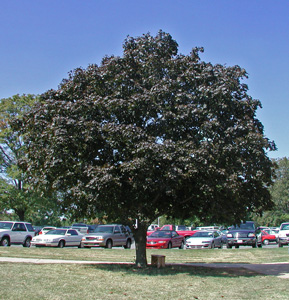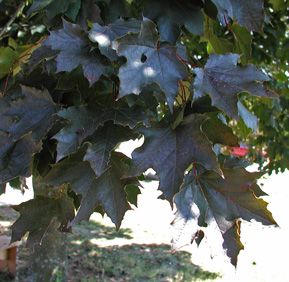Resource Library
Plant of the Week: Crimson King Maple
The University of Arkansas System Division of Agriculture does not promote, support or recommend plants featured in "Plant of the Week." Please consult your local Extension office for plants suitable for your region.
Plant of the Week
Crimson King Maple
Latin: Acer platanoides

I have a sweet tooth, so I have trouble foregoing a toothsome delight even though I know I should. I have the same problem with plants. Trees the self-proclaimed experts pronounce as “bad” tempt me more than the safe choices they proclaim as the best to plant. Crimson King maple (Acer platanoides ‘Crimson King’) is one of the temptations I planted a few months ago.
What are the characteristics of a Crimson King Maple?
Crimson King maple is a selection of Norway maple, a tree now widely naturalized in the cooler, more moist parts of the northeast and New England states. It is a round-headed 45-foot-tall tree with dense branching and a single stout, gray turning to black, trunk. Like most large maples, it is shallow rooted and, combined with its dense canopy of leaves, a strong competitor for other plants growing near it. Norway maples have yellow fall color that appears two to three weeks later than sugar maple.
Crimson King has the same general form as the species, but is very slow growing but can be expected to attain the same size of the normal Norway maple in 35 to 40 years. It has five-lobed, sharp-pointed, long-petioled leaves that are 5 inches long and wide. The deep maroon color of the leaves persists throughout the growing season. When the leaves are removed from the stem, a couple dots of white latex will be visible. This characteristic and the thicker texture of the Norway maple leaf is an easy way to separate this species from the sugar maple, which has a similarly shaped leaf. Crimson King completely lacks fall color, turning from maroon to singed-looking gray-black as fall progresses.

Norway maple is now a much maligned tree because it has escaped cultivation in the colder parts of the nation. Part of the reason for its widespread escape in the northeastern states is because of Dutch elm disease. When this dreaded disease of the American elm devastated street tree plantings of elms in the 1940s and 50s, there was a scramble to replant with something to restore shade. Norway maples were faster growing than sugar maples and they were available in sufficient numbers to start the replanting efforts. After five decades the tree’s potential for escape cultivation became apparent. It is not a threat of escape in the South, in fact it languishes in zone 7 and refuses to grow at all south of that.
Crimson King is one of several maroon-leafed Norway maple clones, but it is by far the most common. It was raised as a seedling of ‘Schwedleri’, the original maroonish-leafed Norway maple that has been kicking around the nursery trade since at least 1869. Crimson King was raised from seed in Belgium in 1937 where it made its way to the U.S. in 1948. It was one of the early patented trees and as such was highly promoted in the nursery trade. A dozen or so newer and probably slightly better maroon leafed clones are now available but they lack the name recognition of this old standby.
Is Crimson King right for my landscape?
Crimson King maple is best used as a stand-alone lawn specimen in the landscape. If the lower limbs are pruned up so that the first ones are at least 8 feet off the ground, even bermudagrass will manage to persist beneath the tree in an irrigated lawn. Crimson King is not very drought tolerant so during dry years leaf scorch is common in the south. Trunk wrap during the first two years after planting will also reduce the likelihood of sun scald on the smooth, gray trunk.
Check out our page on tree care and planting tips for more information.
By: Gerald Klingaman, retired
Retired Extension Horticulturist - Ornamentals
Extension News - September 13, 2013
The University of Arkansas System Division of Agriculture does not maintain lists of retail outlets where these plants can be purchased. Please check your local nursery or other retail outlets to ask about the availability of these plants for your growing area.